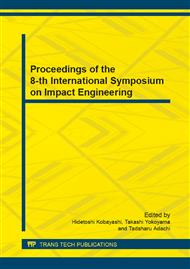p.586
p.593
p.599
p.605
p.611
p.617
p.623
p.629
p.637
Damage Evaluation by Impulsive Response in Structure Filled with Liquid
Abstract:
A double-walled liquid mercury target vessel, which consists of outer and inner walls, is being globally developed for MW-class spallation neutron sources. When proton beams bombard a mercury target, pressure waves are generated due to the rapid thermal heat deposition. These pressure waves trigger impulsive vibrations in the mercury vessel, and cause cavitation damage to the inner wall of the vessel. In this study, the dependency of the vibration behavior of the mercury vessel on the damage is systematically investigated through numerical simulations and experiments, for inner wall damage characterized by hole diameters of 1, 5, 10, 20, and 40 mm. A method referred to as wavelet differential analysis is developed, and a parameter referred to as average intensity is derived for a quantitative damage evaluation. Both the numerical simulation and experimental results show that the average intensity is damage-sensitive and depends on the damage feature size. The critical damage hole diameter is estimated to be 10 mm during damage evaluation.
Info:
Periodical:
Pages:
629-636
Citation:
Online since:
June 2014
Authors:
Price:
Сopyright:
© 2014 Trans Tech Publications Ltd. All Rights Reserved
Share:
Citation:


